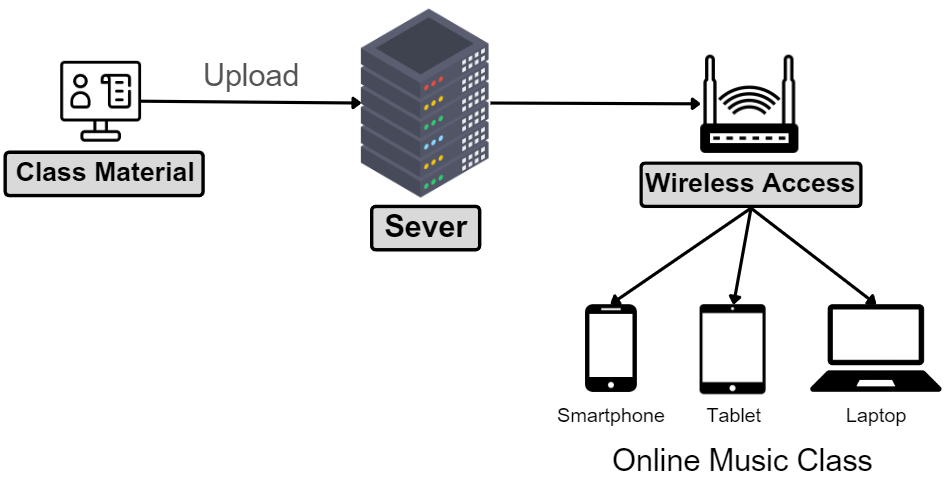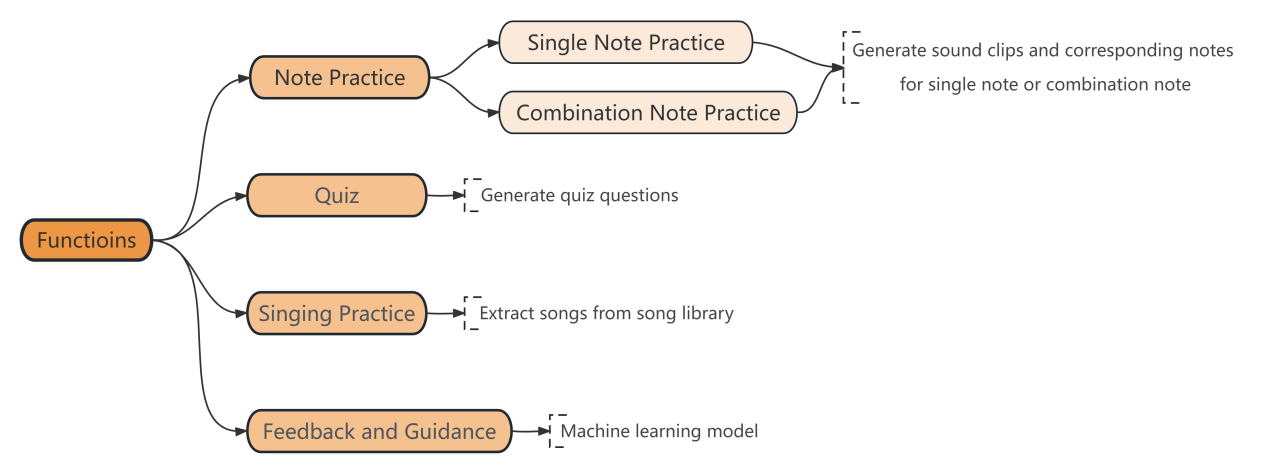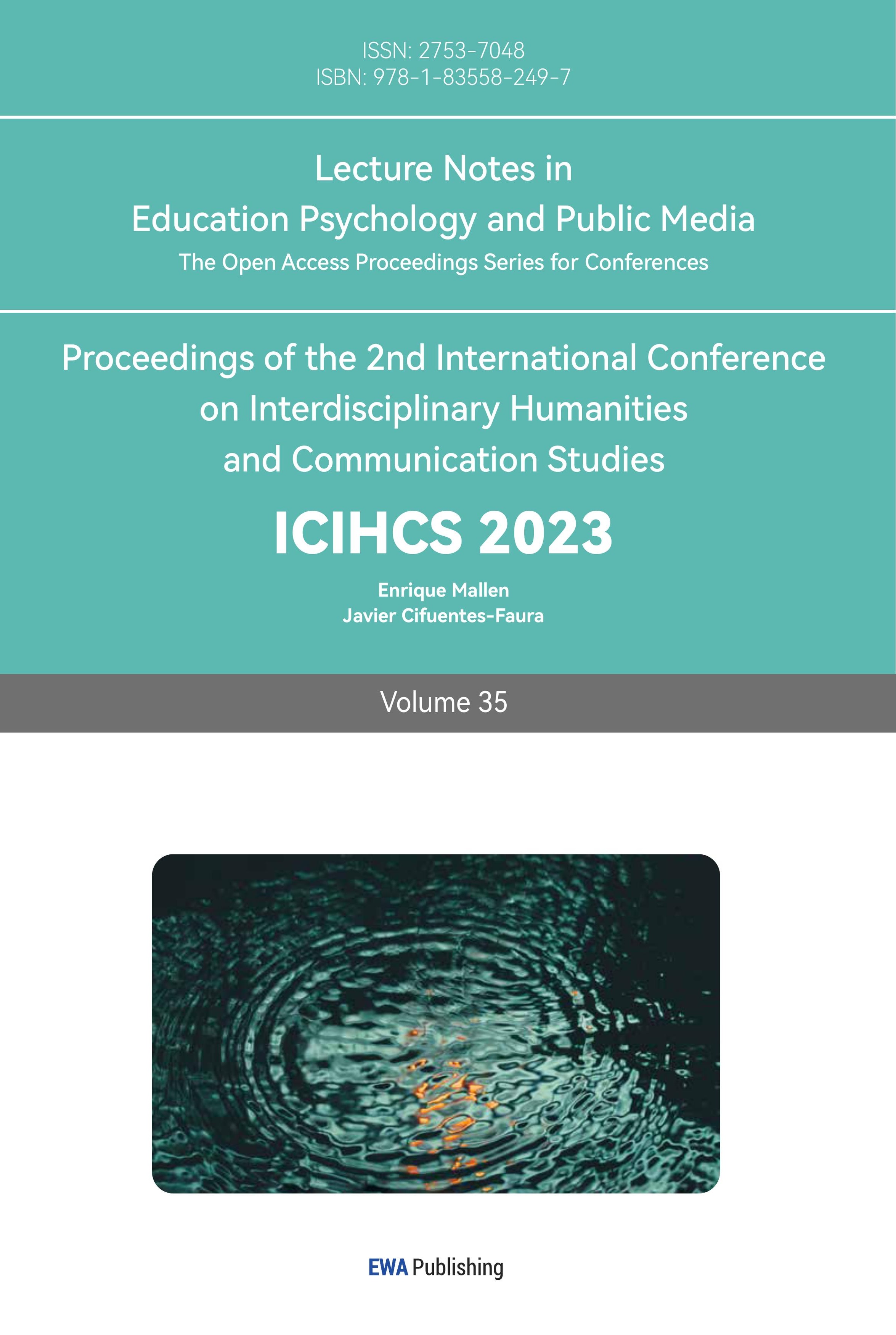1. Introduction
Artificial intelligence technology is an artificial computer unit that solves complicated problems [1]. This technology allows machines or systems to think like humans and deliver the information to be output in a way that is familiar to or similar to humans. As a new computer science technology that has just developed, artificial intelligence technology is used in various fields including humanities, science, medical diagnosis and education [2-4]. In the field of high-tech, AI has raised the upper limit of technology [5]. In traditional industries, AI innovation has made it more flexible and efficient. The application of AI will change the workplace in some related fields, such as education [6]. Online education and artificial intelligence education (computerization of education) are in great demand, proving the important position of computers and artificial intelligence in the field of education [7]. The role music plays in people's lives is limitless, whether in emotion, health or entertainment [8]. On the other hand, music education is a crucial step in enhancing human quality [9]. It is employed to nurture the musical aesthetic sensibility of the next generation and cultivate their musical aesthetic ideas [9]. Music teaching is an indispensable and important part of the music community. It includes music history, culture, regional differences, music theory teaching, singing teaching, including teaching of various musical instruments. Music teaching also includes many different branches, including music history, music culture, regional differences in music, music theory teaching, audio-visual ear training teaching, and singing teaching. Continuing to branch down, it is the teaching of different types of musical instruments, including string instruments, percussion instruments, keyboard instruments, etc. Music education is a large and complex system. Combining music education with artificial intelligence technology can achieve rational and effective utilization of music resources to a large extent.
The integration of AI technology with music education has achieved satisfactory integration results after being put into practice in some schools. "Flipped Classroom" is a teaching model that combines offline teaching and online teaching [10]. In flipped classrooms, smart devices that combine AI technology are the communication bridge between educators and learners [10]. Additionally, the help of AI technology in music education is not only reflected in the interaction between teachers and students. After linking with various external music resource platforms through the Internet, the artificial intelligence system achieves reasonable integration and efficient use of music resources [9]. A music learning model based on the Radial Basis Function (RBF) algorithm was suggested after studying the artificial intelligence-based interactive teaching music intelligence system [11]. They integrated the neural network model and RBF algorithm into the artificial intelligence teaching system [11]. This approach empowers teachers as the primary guides in teaching, while the artificial intelligence system provides valuable assistance [11]. This synergy creates a more engaging music classroom experience [11]. Additionally, Hua et al. used the Sparse Code Multiple Access (SCMA) system multiuser detection algorithm to evaluate and structure the music teaching function system [12]. This system can greatly enhance the efficiency of music learning for the audience and offer evident advantages to students [12].
This paper is mainly to review the widespread application of AI technology in music education according to existing development results. And also includes some assumptions about the future direction of AI music education. A music education system can be created wherein personalized learning experiences are tailored for students, resembling the guidance of a genuine music teacher. Different learning methods and materials are generated based on the unique characteristics of each student. Section 2 of this article provides a brief introduction to three popular AI music education models. Section 3 is about AI application and discussion about music education. The fourth and final section is the conclusion, it summarizes and concludes the content described in the entire paper.
2. Method
2.1. Flipped Classroom
The flipped classroom integrates both online and offline teaching approaches, which reshape traditional teaching methods [10, 13]. It represents a significant shift in the traditional approach to teaching and learning, propelled by technological advancements [14]. In traditional classrooms, lectures are delivered in-person, with students completing assignments independently outside class hours. However, in a flipped classroom, the learning process is reversed. Educators develop educational resources like pre-recorded videos and digital documents, which are accessible through online platforms. Learners can easily access these materials from the comfort of their homes, often utilizing mobile devices or laptops. Classroom time is then used for interactive activities, discussions, and problem-solving, with the teacher acting as a helper rather than a lecturer. In this model, the relevant technology plays a crucial role. In the system, the teaching materials are accessible on the organization's server, teachers and students use interactive systems for learning. The processes are shown in Figure 1 below.

Figure 1: Flipped classroom processes [10].
This intelligent system employs the algorithm Convolutional Neural Networks (CNN) to manage content delivery. CNN algorithms automatically extract features from course materials, enhancing comprehension through visualizations. With training, the model classifies materials, tailoring the learning process efficiently to individual students. In essence, the flipped classroom leverages technology to create a dynamic and interactive learning environment, where students have more control over their learning pace.
2.2. RBF Algorithm System for Music Teaching
The concept of the AI method based on the RBF algorithm in music education revolves around a sophisticated interactive learning system [11]. Different from the flipped classroom, this kind of teaching is teacher-led and assisted by an artificial intelligence system. In this system, data obtained from user interactions, referred to as "nodes", are presented to educators in a man-machine format. This approach creates a closed loop where teachers continually enhance their teaching methods based on the results, incorporating feedback to improve their strategies and self-awareness.
The method employs a neural network structure comprising five layers. The first layer involves input factors related to various music indicators, which are fed into the neural network. The second layer incorporates membership functions, defining the mathematical expressions for these functions. The third layer focuses on fuzzy rule numbers, aiming to minimize these numbers through sample learning. The fourth layer involves normalization, ensuring consistency with fuzzy rule nodes. Finally, the fifth layer serves as the output layer, evaluating music performance skills based on the TS fuzzy model within the RBF algorithm.
This RBF-based interactive education system integrates algorithms into its platform development and applies them to various functions. By simplifying the RBF method into input, hidden, and output layers, and utilizing large-scale music samples for pre-learning, a comprehensive music knowledge modeling method is developed. This method is then evaluated using a corresponding test platform, resulting in a refined and effective learning approach.
2.3. SCMA Algorithm System for Music Teaching
Hua and colleagues used the multiuser detection algorithm of SCMA system to develop a strong music teaching system [12]. The study utilizes methods like posterior probability calculation and interference control to decode the users' sent code words effectively. The sparse factor graph in SCMA technology allows for the optimization of the Maximum A Posteriori (MAP) algorithm, leading to efficient multiuser differentiation. The "efficient multiuser differentiation" refers to the application of algorithms to effectively distinguish and recognize the individual learning needs and progress of multiple users in a multi-user environment.
In this context, the SCMA system multiuser detection algorithm can be employed to differentiate multiple students learning music online simultaneously. This algorithm analyzes the music instructions sent by each student, identifying their unique learning needs and progress levels. This differentiated recognition of multiple users has the potential to enhance system comprehension of each student's unique learning circumstances, facilitating the tailored delivery of educational materials and individualized guidance.
3. Application and Discussion
3.1. Discussion of Previous Methods
Flipped classroom, the integration of intelligent systems in a classroom changes music education, offering a range of advantages while posing challenges and limitations. One of its significant strengths lies in personalized learning experiences. By utilizing artificial intelligence, the system customizes music lessons according to individual student's learning styles and abilities, fostering a more profound comprehension of musical concepts. Furthermore, the intelligent system ensures teaching flexibility, allowing students to revisit materials and practice at their own pace, promoting continuous learning. However, numerous challenges lie ahead. The foremost issue revolves around the issue of accessibility; students lacking the requisite technology and a reliable internet connection may risk falling behind. Additionally, online digital education may lead to reduced face-to-face communication among students, as well as between students and teachers. The basic social skills of students might not be developed adequately.
The RBF-based interactive education system offers a fresh perspective and approach to music education. By closely integrating teacher guidance with interactive learning, educators can refine their teaching strategies based on continuous student interactions, enhancing the learning experience. However, the algorithm's complexity increases the demand for skilled developers and maintenance personnel, potentially increasing operational costs. Additionally, extensive data usage raises concerns about privacy and security. There are some points about how to address these challenges in the future. Prioritizing data security and refining personalized learning experiences will optimize educational outcomes. Collaborations between music education and artificial intelligence science can promise diverse educational avenues.
The music teaching system based on SCMA system is powerful. This system efficiently manages students' assignments and online courses. By analyzing individual students' music instructions, it tailors educational materials, offers personalized guidance, and adapts to diverse learning needs. Despite its potential, the SCMA system's complexity requires skilled handling. Managing multiple users' unique learning requirements demands intricate algorithms and significant computational power. In environments with limited resources, the effective and efficient implementation of this system becomes a challenge. In the future, improving the SCMA algorithm shows great potential. simplifying its complexity and enhancing user-friendliness will universalize online music education, making it accessible to a broader audience.
3.2. Singing Teaching System
By incorporating artificial intelligence technology, it is possible to develop a music education system that caters to individual learning needs, providing customized educational experiences for students, resembling the guidance of a genuine music teacher. Different learning methods and materials are generated based on the unique characteristics of each student. Through sophisticated algorithms and data analysis, the system adapts to individual learning paces, preferences, and strengths, ensuring that students receive customized instructions and exercises that align with their specific needs. In this application, students can follow the tutorials to practice singing and get automatic feedback and improvement methods from the system. Subsequently, the system will also personalize the learning content based on the current learner's weaknesses and learning progress. Figure 2 shows the teaching content materials, test questions, and content generation of the feedback system in the application. Among them, the machine learning model is used to generate learning feedback. Moreover, Natural Language Processing (NLP) algorithms enable real-time feedback and interaction, allowing students to ask questions, seek clarifications, and engage in dialogue, simulating personalized teacher-student interaction.

Figure 2: Content generation for intelligent music teaching systems (Photo/Picture credit: Original).
4. Conclusion
In this article, three prominent applications of artificial intelligence technologies in AI education are discussed, namely, the introduction of the "flipped classroom" concept, the utilization of the "RBF-based interactive education system", and the application of the "SCMA multiuser detection algorithm". These methods share similar instructional patterns but employ different AI technology cores, utilizing the CNN model, RBF algorithm, and SCMA multiuser detection algorithm, respectively. Each method possesses distinct advantages. However, these three techniques have been primarily applied within the context of music classrooms, implying continued teacher involvement. In the future, these AI methods could extend beyond classrooms to individual learning scenarios. Future developments might involve creating open-access AI music education software accessible to non-music majors, akin to the "Singing Teaching System" mentioned in this article, thereby promoting the widespread adoption of AI music education. By developing user-friendly and accessible AI music education platforms, individuals from diverse backgrounds and disciplines can benefit from personalized learning experiences.



